NASA gives four projects $3 million to develop potential space missions
It's all part of the agency's Discovery Program.
NASA has announced four projects as part of its Discovery Program, which sees the space agency asking scientists to pitch focused, relatively low-cost missions for it to take on and develop into full-fledged missions. "Although they're not official missions yet and some ultimately may not be chosen to move forward, the selections focus on compelling targets and science that are not covered by NASA's active missions or recent selections," NASA writes on its website.
The first of the potential missions is called Deep Atmosphere Venus Investigation of Noble gases, Chemistry, and Imaging Plus or DAVINCI+. It would analyze the atmosphere of Venus and attempt to determine if the planet had an ocean in the past. It would also help scientists better understand how the planet's atmosphere formed. Another Venus-focused mission called VERITAS or Venus Emissivity, Radio Science, InSAR, Topography, and Spectroscopy would travel to the planet to create detailed, three-dimensional maps of its surface. It would also track infrared emissions so that NASA can get a better idea of Venus' geology.
Next, there's the Io Volcano Observer or IVO for short. It would travel to Io, one of Jupiter's 79 known moons, to perform several close-in flybys and collect data on the satellite's magma eruptions. NASA says the mission has the potential to revolutionize scientists' understanding of how rocky, terrestrial bodies are formed. Lastly, there's the TRIDENT project. It would go to Triton, one of Neptune's moons, to perform a single flyby. In the process, it would map the moon and attempt to find out if Triton has a subsurface ocean.
NASA says it will provide each study with $3 million to polish its proposal. Sometime next year, the agency will pick up to two of the studies to further develop. One of the more recent missions to come out of the Discovery Program includes the InSight lander, which has been attempting to dig through the surface of Mars. Another Discovery Program alum is the Lunar Reconnaissance Orbiter, which late last year pinpointed the crash site of India's Vikram lander.


